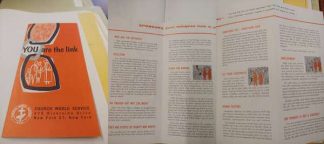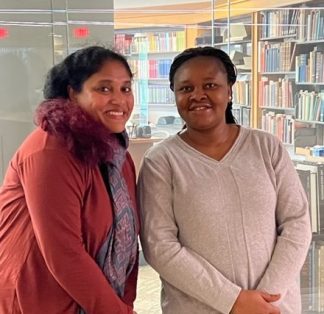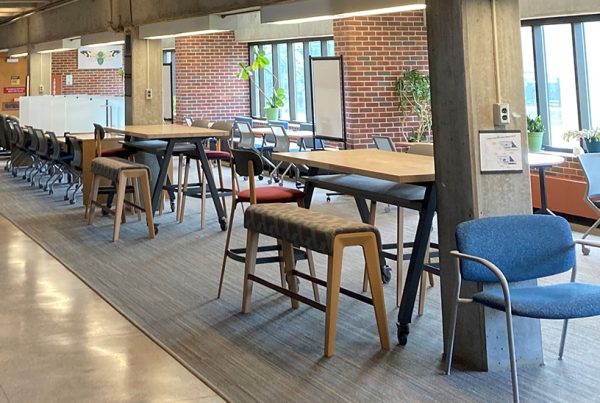by Debjani Chakravarty, PhD, University of Utah
Spotlight on Research: Guest author Debjani Chakravarty was awarded the Immigration History Research Center Archives (IHRCA) Grant-in-Aid Award this past year. She visited Andersen Library for five days to study the topic of invisible labor — a form of labor that is unacknowledged and uncompensated, but crucial to functioning of social institutions and organizations.
I am currently researching the notion of invisible work. During my visit to the Immigration History Research Center Archives (IHRCA) recently on a Grant-in-Aid award, not only did I gather the kind of insights only archives can provide, but also had some inspiring conversations that helped me sharpen my focus. As a feminist sociologist, I am fascinated by the notion of work — any format of exertion that sustains society and humanity, lives, and livelihoods. Related issues of labor — including division of labor, gendered labor, maintenance labor, emotional labor, and labor under capitalist and precapitalist regimes — interest me as well.
While writing and researching on the nature and notion of domestic labor (both paid and unpaid) and academic labor, I have been thinking a lot about the nature of invisible labor — essential labor that is unacknowledged and uncompensated not in the sphere of housework, but in the broader economy. This has now become a guiding research interest and my next academic project.
What are the forms of invisible labor that keep turning the wheels of global capitalism? Whose invisible labor preserves the disproportionately large service economies of the so called “first world?” What labor is visible and what is not — and is the latter mostly uncompensated? What are the formats of material and symbolic compensation?
To understand these issues, I began exploring the nature of work itself and how it is connected to moral values and social norms. Marxist approaches in sociology and feminist/gender studies provide a strong framework for understanding value and work as well as value of work. As an immigrant myself, I started wondering about the value of immigrant labor. I am not an economist, and I am not looking for total immigrant contributions to the Gross Domestic Product of a nation such as the United States; many have explored and quantified this. Instead, as a sociologist, I am interested in how the value of work is presented to immigrants and forced immigrants, such as trafficked human beings and refugees, and how the worker identity and immigrant identity might converge.
This was the entry point for my interest in the IHRCA collections—invisible labor, maintenance labor, background work, “ghostwork” done by immigrants across sectors that strengthen social institutions and their essential practices but remain unacknowledged and often uncompensated.
My visit to the archives was exploratory research in every sense, a groundwork for my future mixed methods study. I initially thought that personal correspondence between immigrants and their family/friends back home, refugee narratives, and oral histories of labor union leaders and community activists would illuminate the nature of invisible labor well. I realized that “invisible labor” would not be the best keyword for my search as this particular expression is rarely used now and was possibly even more rare (if used at all) in the 20th century. I only had a week to explore the IHRCA, so I decided to look at institutional records: from the International Institutes of Minnesota, San Francisco, Buffalo, etc., as well as Immigration and Refugee Services of America (IRSA), AFL-CIO, YMCA, Children’s Bureau, and other community organizations. I sought materials to help me understand how the notions of “work” and “labor” were framed for immigrants and refugees.
In my pre-visit consultation with IHRCA curator Ellen Engseth, she helped me find several personal accounts that reference invisible labor, such as in a memoriam poem for Katri Saari, located in the Minnesota Finnish American Family History Project records. While finding more of these intimate, personal records would have likely revealed gendered aspects of invisible labor as well as its emotional costs, alienation, and other struggles, I decided instead to focus on institutional records. These records can shed light on public and/or official pronouncements on the norms, ethics, and value of work vis-à-vis immigrants and refugees. Both Engseth and assistant archivist Maura Coonan greatly helped me find and navigate institutional records from the early 20th century to the 1980s.
The following show some interesting examples of how the value of work is enshrined in institutional records as an All-American value, a strong social expectation, and the essence of immigrant life. It is also interesting to see how institutional rhetoric has changed over time following, not economic cycles, but public perceptions and populist appeals. In other words, politics.
Immigrants have always been understood as economic assets in the United States and, to some extent, cultural assets. Both identities feature the expectation of visible as well as invisible labor as implicit and embedded. Both governmental and non-governmental entities discussed the state of the economy vis-à-vis immigration, painting the picture of the United States of America as driven by the dual ideals of freedom and equality; a refuge for displaced and persecuted peoples around the world, featuring a meritocratic competitive economy where human beings can be productive and free. The notions of productivity and human dignity thus go hand-in-hand: the ideals of equality and employment are inseparable.
Immigrants are presented as hardworking and heroic in addresses and testimonials of community organization leadership and immigration activists from the early 20th century. In an address post-WWII, Argyle R. Mackey, Commissioner of Immigration and Naturalization in the organization now known as the USCIS, said about the immigrants, that “theirs has been a thrilling and heroic episode in the story of America. Never has any nation equaled the enlightened course of the United States in welcoming such an immense influx of newcomers. And never, may I add, has any nation derived such incalculable benefits from the contributions of such newcomers and their descendants to the development of our resources, the building of our strength, and the richness of our national life.” (1950, in a workshop of American Federation of International Institutes, Pennsylvania; located in the Immigration and Refugee Services of America records, Box 266A, folder 1.)
In my sampling of governmental and community documents, one issue becomes clear: expressions such as heroic, hardworking, and energetic are usually reserved for white male immigrants. Non-white immigrants are often portrayed as helpless and unskilled.
Yet there’s hope for them, such as in a Resettlement Memoranda for Indochinese refugees from 1975 that states that “Realistically, public assistance is an essential ingredient of the total program . . . the vast majority of presently dependent refugees will become tax paying, self-supporting, productive and contributing members of our society.” (Immigration and Refugee Services of America records, Box 321, folder 9.)
Ellen Engseth suggested that for understanding the nature of invisible labor, looking at volunteer work might be useful. This opened up a whole vista of community organizations focused on new immigrants and refugees, and how much volunteer work was needed for their support programs to be functional. Such volunteer, unpaid, charitable work had a strong class and gender aspect. Upper class white women with leisure were expected to contribute, as well as “integrated” immigrants of all genders and classes, particularly in big cities such as New York, Chicago, Minneapolis, and Detroit.
My short visit to the Immigration History Research Center Archives revealed several characteristic features of labor and invisible labor vis-à-vis immigration: a) that such labor is gendered and racialized in policy as well as popular imagination; b) that invisible labor is political, hierarchical, and taken-for-granted, and essential to running of social institutions co-constituting and beyond the capitalist economy; and that c) inherent in benevolent and charitable rhetoric towards immigrants and refugees is expectation of nationalist assimilation, potential for exploitation, and homogenizing invisibility, especially if such immigrants and refugees are nonwhite and come from historically colonized societies.
The dignity and humanity of immigrants are tied to their productivity in the national imagination and, when advantageous, this humanity has been taken away as immigrants and refugees have been reduced to “aliens,” “foreign elements,” “different,” and “burdens.” I must revisit the archives if I wish to continue tracing connections between invisible labor and immigration. For now, I have a lot to unpack from my archival data about capitalist labor, traveling labor, alienation, and public perceptions of what work and which worker is valuable and visible.






